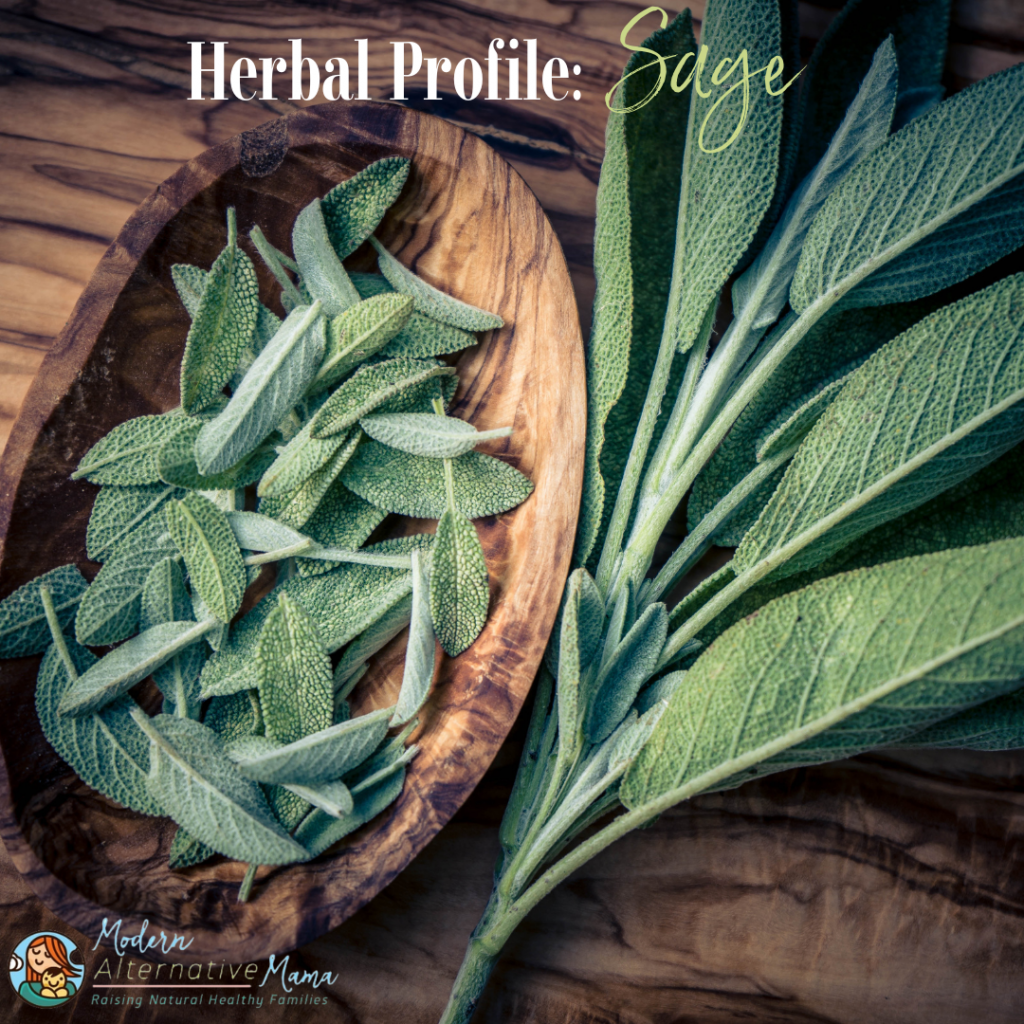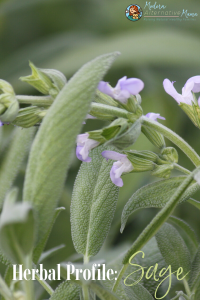What is Sage
Sage, sometimes referred to by its scientific name Salvia officinalis, is a perennial herb and evergreen shrub from the mint family. Sage has oval, dusty gray-green leaves with velveteen hair-like projections on sage leaves and woody stems. Because of the fine, slightly fuzzy, and cottony texture, sage can be unpleasant to eat raw (1). Nonetheless, when cooked, sage is prized for its strong herbal aroma and earthy flavor.
Health Benefits of Sage
Sage is used in savory recipes, but it is also brimming with health benefits, including, but not limited to:
Rich in Nutrients
Sage leaves are typically used in herbal supplements or cuisine. Sage contains vital nutrients, including fiber, calcium, iron, magnesium, phosphorus, potassium, zinc, manganese, selenium, and vitamins A, B6, C, and K (2).
Antioxidant Properties
Sage is packed with 160 distinct polyphenols that act as antioxidants in your body (3), which help neutralize or prevent the harmful effects of free radicals in the body. The buildup of free radicals has been linked to chronic diseases, such as cancer and heart disease (4). Sage also contains Chlorogenic acid, caffeic acid, rosmarinic acid, ellagic acid, and rutin (5), all linked to pharmacological properties, such as a lower risk of cancer and improved brain function and memory (6).
Antibacterial Properties
An antibacterial property is when a substance, or in this case, an herb, can destroy or suppress the growth and reproduction of bacteria (7). Sage contains certain compounds that have potent antibacterial properties. One study found that sage mouthwash effectively reduced Streptococcus mutans in dental plaque (8).
May Reduce Blood Sugar Levels
As of 2020, 34.2 million (1 in 10) Americans have diabetes, and another 88 million (1 in 3) Americans have prediabetes (9). On the bright side, sage has been used traditionally as a remedy against diabetes. Animal studies have found sage extract reduced blood glucose levels in rats with type 1 diabetes by activating a specific receptor, in turn improving insulin sensitivity (10,11). Another animal study found that sage tea acts like metformin in mice with type 2 diabetes (12). In human studies, sage leaf extract has demonstrated the ability to lower blood sugar and improve insulin sensitivity with a similar effect as rosiglitazone, an anti-diabetes drug (13).
May Support Heart Health
Unfortunately, heart disease is the world’s number 1 cause of death (14). Due to the incredibly complex determinants of heart disease and various possible contributions, it’s hard to pinpoint an exact way to prevent it. Still, you can at least take steps to lower your overall risk. For instance, “bad” LDL cholesterol can build up in your arteries and potentially cause damage (15). Thankfully, several studies have found sage to be a potential solution (16,17).
One study found consuming sage tea twice daily lowered “bad” LDL cholesterol and total blood cholesterol while raising “good” HDL cholesterol after just two weeks (18). Another study demonstrated sage extract’s ability to lower fasting glucose, HbA1c, total cholesterol, triglyceride, and LDL-C but increased HDL-C compared to baseline at the endpoint (19).
May Support Brain Health
As previously discussed, sage is packed with 160 distinct polyphenols that act as antioxidants in your body, but these antioxidants have also been shown to buffer your brain’s defense system (20,21). These antioxidants make sage a perfect candidate for improving brain function in all age groups.
In younger and older adults, sage demonstrates the ability to improve memory and brain function (22,23). In healthy adults, low doses of sage improved memory, while higher doses had the same effect, plus elevated mood, increased alertness, calmness, and contentedness (24).
Additionally, a study found patients with mild to moderate Alzheimer’s disease taking sage extract performed better on tests that measured memory, problem-solving, reasoning, and other cognitive abilities (25). These findings are likely due to sage’s apparent ability to halt the breakdown of the chemical messenger acetylcholine (ACH), which has a role in memory and is a potential cause of Alzheimer’s disease (26).
May Support Oral Health
As discussed earlier, sage has antibacterial properties that effectively reduce the number of Streptococcus mutans in dental plaque. Still, sage is good for more than just that when it comes to oral health (8). In vitro, a sage-based essential oil killed and halted the spread of Candida albicans, a fungus that may also cause cavities (27,28). Additionally, a review noted that sage might treat throat infections, dental abscesses, infected gums, and mouth ulcers (29).
Anti-Aging Properties
Thanks to sages’ antioxidant content that reduces skin damage caused by oxidative stress, it also has anti-aging properties that may improve skin health. For instance, several test-tube studies indicate that sage’s compounds may help fight signs of aging, such as wrinkles (30,31).
May Provide Menopause Symptom Relief
Menopause transpires when estrogen decreases and is characterized by a point in time 12 months after a woman’s last menstrual cycle. In the years leading to menopause, women may have changes in their monthly cycles, hot flashes, or other uncomfortable symptoms (32).
Thankfully, sage has been traditionally used to reduce menopause symptoms (33). Studies indicate that sage’s compounds have estrogen-like properties, allowing them to bind to certain receptors in the brain, helping to improve memory, and reducing hot flashes and excessive sweating (34). Additionally, a study found daily sage supplementation significantly reduced the number and intensity of hot flashes over eight weeks (35).
Anticancer Properties
Statistics say that 158.3 of every 100,000 individuals will die from cancer, but what if they didn’t have to (36)? Thankfully, animal and test-tube studies indicate that sage not only suppresses the growth of cancer cells but also stimulates cell death of the mouth, colon, liver, breast, skin, and other cancers (37,38,39,40,41,42).
Safety Concerns
The mainstream cautions against using sage while pregnant or breastfeeding (43). This is one of the rare instances where the mainstream is correct. According to trusted herbalist Richard Whelan, for most people, young or old, sage is a very safe medicine that can be used in high doses if required. However, sage may be best avoided as a high-dose medicine during pregnancy. Additionally, sage has traditionally been used to help dry up breast milk, so it should not be taken during breastfeeding unless coming to an end (44).
Regarding sage essential oil, trusted aromatherapist Wendy Robbins cautions never to use any essential oils internally or undiluted. She also warns of its high thujone content stating to use it sparingly and with extreme caution due to the possibility of neurotoxicity. She also states to avoid sage essential oil in pregnancy and breastfeeding and recommends a dermal maximum of 0.4% (45).
How to Use Sage
You can find sage in dried bulk, pills, powders, teas, extracts, or tinctures. Tinctures always contain the most concentrated amount of herbs. Teas and soups are also options, especially when following ayurvedic medicine recipes. Some great articles to check out featuring the use of sage include:
Follow the recommendations of any supplement; some of my recommendations include:
- Earthley’s Detox Bath can support your body during a detox, during an illness, or just because you want to relax in a lovely scented soak. This blend can help with joint and muscle pain, headaches, lymphatic congestion, and rashes.
- Frontier Co-op Organic Rubbed Sage Leaf is grown and harvested in Albania.
These sage leaves are dried, cut, and sifted to create a flavorful blend. No artificial additives or chemicals are used during the growing and harvesting processes.







